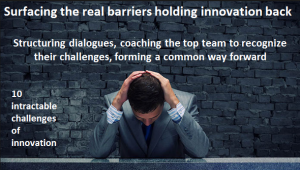 A Question:
A Question:
If you could ask those that lead innovation, your senior organizational leadership, a series of questions that might help unlock innovation blockages, now would that be valuable?
Getting to a root cause of innovation blockage
So what does block innovation? Arguably there are plenty of things up and down organizations: a lack of resources, an overcrowded portfolio of ideas, a lack of dedicated people, treating innovation as a one-off, keeping it isolated and apart from mainstream activities.
The list could go on and on, no question but to seek out a meaningful exchange of minds let me offer these outlined below as ones to tackle. Get a discussion going on all of these needs ‘being selective’, raised at separate times and then integrated into a collective ‘declaration of innovation intent’ going forward.
Let’s take a different perspective.
If you could ask a series of questions that might help unlock innovation blockages it would make such a difference to our innovation performance and engagement. I think this might need a good external facilitator as my recommendation, one who has deep innovation knowledge and expertise, able to manage the ‘dynamics’ within the room.


